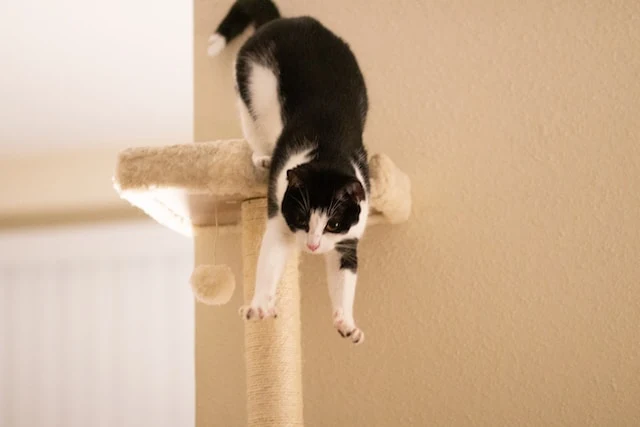I. Introduction: The Fascinating Phenomenon of Cats' Agility
Cats have long been admired for their extraordinary ability to always land on their feet, no matter how high the fall. This seemingly gravity-defying act has captivated the curiosity of humans for centuries. How do these graceful creatures manage to twist and turn in mid-air, effortlessly correcting their balance? The answer lies in their remarkable agility, intricate anatomy, and innate survival instincts. In this article, we will delve into the fascinating world of cats' aerial acrobatics, exploring the physical adaptations, scientific principles, and behavioral aspects that enable them to perform this uncanny feat. Join us as we unravel the secrets behind how cats always manage to land on their feet.
Cats have always been known for their remarkable ability to land on their feet, no matter how high or awkward the fall. It's a mesmerizing sight to see a cat gracefully twist and contort its body mid-air, defying gravity like a feline acrobat. But how exactly do they do it? Let's dive into the world of cats and explore the secrets behind their incredible agility.II. The Anatomy of a Cat: Understanding Their Remarkable Physical Adaptations
A. Muscular and Skeletal Structure
Cats possess a unique muscular and skeletal structure that allows them to execute their mind-boggling aerial maneuvers. Their muscles are highly elastic, giving them the flexibility and strength needed for maximum agility. In addition, their bones are lightweight yet sturdy, enabling quick and precise movements without compromising their overall stability.B. Flexible Spine and Limbs
One of the key elements in a cat's acrobatic repertoire is its exceptionally flexible spine. Unlike humans, who have a rigid backbone, cats have a spine with numerous small bones that provide them with remarkable spinal flexibility. This allows them to twist and rotate their bodies effortlessly, adapting to different positions while in mid-air. Furthermore, their highly flexible limbs act as shock absorbers, minimizing the impact upon landing.C. Sensitive Whiskers and Tails
Cats are notorious for their keen sense of balance, and part of that can be attributed to their sensitive whiskers and tails. Whiskers serve as sensory organs, providing cats with vital information about their surroundings, such as detecting changes in air currents. Similarly, their tails act as a counterbalance, helping them adjust their body positioning while in mid-air. This combination of sensitive whiskers and tails enhances their overall stability during their gravity-defying feats.III. The Role of the Vestibular System in Cats' Ability to Orient Themselves
A. The Inner Ear and Balance
To understand how cats manage to land on their feet so precisely, we must delve into their vestibular system. Cats possess a complex inner ear structure that plays a crucial role in maintaining their sense of balance. This intricate system helps them detect motion and changes in head position, ensuring their stability and coordination even in mid-air.B. The Vestibular Apparatus and Orientation
Within the inner ear lies the vestibular apparatus, a network of fluid-filled canals and tiny hair cells that work together to provide cats with a sense of orientation. When a cat falls, these canals and hair cells detect the change in position and send electrical signals to the brain, allowing the cat to quickly adjust its body to land on its feet. It's like having an internal gyroscope that keeps them in perfect equilibrium.IV. The Gravity-Defying Act: Unraveling the Secrets of the Righting Reflex
A. How the Righting Reflex Works
The main star behind a cat's ability to land on its feet is the remarkable righting reflex. This reflex is an innate self-righting mechanism that kicks in when a cat falls. As soon as they sense they are in free fall, their body automatically goes into action. The cat tucks its limbs in, arches its back, and rotates its head and torso simultaneously to align itself with the ground. This rapid adjustment allows them to land on their feet or, at the very least, minimize the impact on their bodies.B. The Role of the Cat's Eyes in Righting
In addition to their extraordinary reflexes, a cat's exceptional eyesight also plays a crucial role in their mid-air acrobatics. Cats have binocular vision, which means they can perceive depth and distance accurately. This visual skill enables them to calculate the precise moment to twist their bodies during a fall, enhancing their chances of landing gracefully.
So, the next time you witness a cat gracefully descending from a height, remember that it isn't just luck or magic. It's a combination of their unique anatomy, remarkable balance, and lightning-fast reflexes that allow them to conquer gravity with ease. Cats truly are the masters of defying the laws of physics, all while maintaining their oh-so-cool feline composure.
V. The Cat's Remarkable Flexibility: The Spine and Limbs in Action
A. The Cat's Unique Spinal Structure
Cats are known for their extraordinary flexibility, and this ability is largely attributed to their unique spinal structure. Unlike humans and many other animals, a cat's spine is exceptionally flexible due to its numerous vertebrae and specialized muscles. These vertebrae allow cats to twist, turn, and bend their bodies in ways that seem almost supernatural.
B. The Role of Limber Limbs in Mid-Air Maneuvers
In addition to their flexible spines, cats possess remarkably limber limbs that play a crucial role in their mid-air maneuvers. Their front legs can rotate individually, allowing them to adjust their body position while in flight. This extraordinary limb flexibility, combined with their keen balance, gives them the ability to make split-second adjustments and land on their feet with precision.
VI. Physics at Play: Conservation of Angular Momentum
A. Understanding Angular Momentum
Now, let's dive into the physics behind a cat's incredible mid-air acrobatics. Angular momentum is a fundamental principle in physics that describes the rotational motion of an object. It depends on both the object's mass and the distribution of that mass about its axis of rotation.
B. How Cats Utilize Angular Momentum to Land on Their Feet
Cats are masters of utilizing angular momentum to land on their feet. When a cat begins to fall, it instinctively rotates its body using its flexible spine and limbs. By changing the position of its limbs, the cat can alter its moment of inertia, which in turn adjusts its rate of rotation. This allows the cat to orient itself in mid-air and control its descent, ensuring a safe and graceful landing.
VII. Training and Development: How Kittens Learn to Land on Their Feet
A. Instincts vs. Learned Behavior
While a cat's ability to land on its feet seems innate, it is also a learned behavior that kittens develop over time. Kittens start practicing their righting reflexes as early as four weeks old. Through trial and error, they gradually refine their techniques and learn to land safely.
B. The Role of Play in Developing Coordination
Playtime plays a crucial role in a kitten's development of coordination and balance. When kittens engage in playful activities, such as chasing toys or pouncing on their siblings, they unknowingly train their muscles and fine-tune their reflexes. This physical activity helps them understand their body's capabilities and enhances their ability to land on their feet.
VIII. Safety Measures: Precautions to Prevent Injuries in Cats
A. Creating a Cat-Friendly Environment
To keep our feline friends safe and free from injuries, it is essential to create a cat-friendly environment. This includes removing potential hazards such as fragile objects, toxic plants, or loose cables that could lead to accidents or falls. Providing sturdy and stable climbing structures and vertical spaces can also help satisfy a cat's natural climbing instincts without compromising their safety.
B. Minimizing Heights and Potential Dangers
While cats are skilled at landing on their feet, it's still important to minimize heights and potential dangers to avoid unnecessary risks. Keeping windows securely screened and balconies enclosed prevents accidental falls. Additionally, providing soft surfaces like carpets or cushioned beds can cushion any potential landings and reduce the impact on their joints.
Remember, while cats may have incredible self-righting abilities, it's our responsibility as pet owners to ensure their well-being and safety by creating an environment that minimizes potential hazards and supports their natural instincts.In conclusion, the ability of cats to consistently land on their feet is a testament to their incredible agility and adaptability. Through a combination of specialized anatomy, a highly developed vestibular system, and the utilization of physics principles such as conservation of angular momentum, cats have mastered the art of mid-air maneuvers. As pet owners, it is important for us to create a safe environment for our feline friends, minimizing potential risks and ensuring their well-being. By understanding and appreciating the extraordinary abilities of our furry companions, we can continue to marvel at their remarkable feats and deepen our bond with these fascinating creatures.





